Improvements in its nutritional value can increase its inclusion in aquafeed formulations
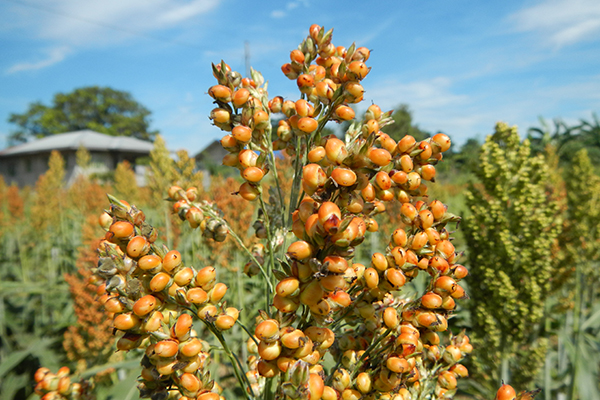
Sorghum is a drought-resistant cereal grain typically cultivated in semi-arid conditions. This grain has been ranked fifth worldwide after wheat, corn, rice, and barley in terms of both production and area planted. Global sorghum production reached over 58.8 million metric tons in 2022, and the United States is currently the fourth producer (after Nigeria, Sudan and Mexico) with about 8 percent of the total production.
Sorghum has long been a principal food crop and a major source of protein, energy, and minerals for millions of people in Asia and Africa. This grain has gained a global reputation in the production of fermented foods due to its wide adaptability and low production cost. Sorghum demand is growing by consumer choice because the grain is a non-GMO (non-genetically modified organism), gluten-free, and high in antioxidants.
Also, sorghum is one of the few crops that can fit into all of the current bioenergy frameworks, including grain-to-ethanol, sweet sorghum sugar into bio-fuels, and as lignocellulosic and cellulosic biomass feedstock for bio-fuels.
Sorghum has also been used as a novel ingredient for developing sustainable aquafeeds.
With a growing demand for aquafeeds, agricultural ingredients such as cereal grains and oilseeds have been introduced in progressively increasing amounts, replacing fishmeal and marine protein sources. Among these ingredients, sorghum grain has potential due to its extensive global production and suitability of nutritional properties; although like any other ingredient, sorghum has its own cons and pros as a feed ingredient for aquafeed development (Table 1).
Ovissipour, Sorghum, Table 1
| Pros | Cons |
|---|
Pros | Cons | ||
|---|---|---|---|
| Large global production | Low protein content | ||
| Sustainable | Lower protein and starch digestibility | ||
| Non-GMO | Negative impact on organ health | ||
| Emerging nutrient source | Deficiency in lysine and threonine | ||
| Good results in omnivorous and herbivores | Anti-nutritional factors | ||
| Great source for value-added products | Limited studies in aquaculture | ||
| High antioxidant level | – |
This article – adapted and summarized from the original publication (Zarei, M. et al. 2022. Sorghum as a Potential Valuable Aquafeed Ingredient: Nutritional Quality and Digestibility. Agriculture 2022, 12(5), 669) – reports on a review of studies on sorghum and its application in aquafeed, emphasizing improving fish productivity when fed high sorghum-based diets. For the original article sections on sorghum biology and agriculture, and nutrient composition (excluded in this summary), refer to the original publication.
Sorghum in aquaculture production
Limited studies are available regarding the application of sorghum as an aquafeed ingredient, although the potential of the grain has been examined extensively in poultry and cattle. Available data, while limited, show that omnivorous fish such as carp and tilapia can digest and metabolize sorghum-based diets.
In common carp, the nutrient digestibility of sorghum has been compared with that of wheat bran and rye. In another study, sorghum or pellets containing 25 percent protein were used to feed common carp in ponds. The results show that feeding on sorghum led to lower growth and higher body fat as compared with feeding on the pellet diet. In sunshine bass, however, sorghum protein and fat digestibility were 60 and 79 percent, respectively, which are similar to those reported for corn.
Indigestible sorghum carbohydrates, such as lignin pentosans and cellulose, are hypothesized to be responsible for the relatively lower digestion efficiency of protein and fat in sunshine bass. Differences in fish species have a critical role in sorghum digestibility and performance, as omnivorous species such as carp digested sorghum better than another fish species such as sunshine bass (Fig. 1).
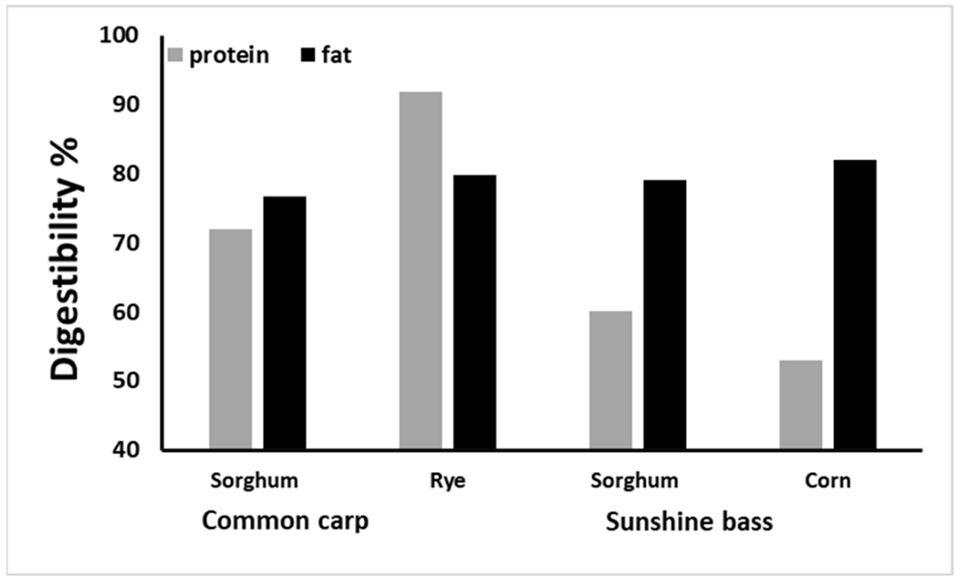
Sorghum’s apparent digestibility has also been evaluated in Florida pompano as a carnivorous species. The digestibility of the dry matter and energy of the sorghum diet are 45.4 and 63.9 percent, respectively, which are lower and higher than that of corn (58.1 and 71.4 percent) and wheat middlings (24.4 and 58.6 percent). The relatively lower digestibility of sorghum has been attributed to the source or type of starch, which needs higher temperatures for gelatinization.
Previous studies evaluating the use of sorghum products in tilapia have yielded some promising but inconclusive results. A comparison of five grain sources (corn, wheat, barley, sorghum and rice) showed that tilapia fed a diet containing 25 percent sorghum had maximum growth performance and superior protein retention efficiency. The addition of sorghum also increased body fat content and reduced body moisture in tilapia. In another study, the growth performance and feed conversion of tilapia fed sorghum hominy at two inclusion rates were shown to be similar to that of tilapia fed a commercial diet. These results confirm the ability of tilapia to use sorghum as the main dietary component at inclusion rates of 25 percent in custom-formulated diets.
Sorghum is also considered a suitable replacement for corn in fish diets. Competition for use in human nutrition and other animal feeds has raised corn market prices and limited its availability. It appears that sorghum as a source of starch has immense potential to replace corn or cassava in omnivorous species. The growth performance in pangasius is reportedly not affected when cassava and corn are replaced with sorghum. In addition, a sorghum diet does not change the fillet color in pangasius or the physical properties of the feed pellets (density and floatability). In silver catfish, the sorghum dry matter and protein digestibility are higher than corn, suggesting that sorghum is a favorable ingredient in catfish feeds.
Supplementation strategies to improve sorghum performance in aquafeeds
The relatively low-protein, high-fiber and anti-nutritional content of sorghum grain restricts its inclusion ratio in high-value aquafeeds for higher trophic species. However, improving its digestibility and increasing the protein content through modification approaches could improve the ability of sorghum to serve as an alternative feed ingredient in aquaculture.
Sorghum-based distilled soluble dried grain (DDGS) is a byproduct of the bio-fuel production industry and contains 28.7–32.9 percent crude protein, 8–13 percent fat and 34.7–51.1 percent fiber. There is interest in using this ingredient in aquafeed owing to its increased supply and low cost. The efficiency of extruded and pelleted sorghum-based DDGS diets has been assessed in two growth studies in Pacific white shrimp. The results indicate that up to 40 percent of this new protein source can be used in feed formulations without affecting the performance of L. vannamei. Similar results have also been observed following the addition of up to 40 percent corn DDGS to aquafeeds for catfish, rainbow trout and channel catfish.
Reducing the impact of anti-nutritional factors
Fermentation, germination, enzymatic hydrolysis, heating and chemical treatments have been employed as solutions to reduce the effect of the anti-nutritional factors. In general, fermentation makes the feed ingredients easier to digest and the nutrients easier to absorb. A combination of cooking and fermentation reportedly improved the nutrient quality and drastically reduced the anti-nutritional factors to safe levels, which is much better than any of the other processing methods tested. The fungal fermentation process was also found to be an effective alternative to enhance the protein content of the sorghum hominy and increase the sorghum protein content by 20 percent.
Improving sorghum digestibility
The low digestibility of sorghum protein and starch, coupled with the low content of the essential amino acids lysine and threonine, are the main obstacles to its further use in animal diets. Genetic engineering tools may be alternatives to enhance kafirin (sorghum protein) digestibility and improve the nutritional value of sorghum grain. Several alternatives have been suggested to improve sorghum feed and food efficiency, including fermentation, chemical modification, enzymatic hydrolysis and thermo-mechanical treatment.
Fermentation
Fermentation has long been used to improve protein digestibility. A substantial increase in sorghum digestibility was reported after 24 hours of fermentation, highlighting that enhanced protein digestibility may be attributed to the fractional degradation of complex storage proteins into simpler and more soluble products. In addition to digestibility, fermentation also influences functional properties, i.e., the pH shift in sorghum protein solubility. The water- and oil-binding capacities of sorghum flour reportedly decreased and increased, respectively, as a result of fermentation.
Chemical modification
Sorghum protein conjugated (linked or connected) to some polysaccharides (type of carbohydrates) has been applied to improve its functional properties. Research showed that conjugation improved protein solubility at all pH levels and emulsification capacity was doubled. Reducing agents, such as sodium metabisulphite and glutathione, have also been used to improve protein and starch digestibility since these agents can break down the protein matrix.
Enzymatic hydrolysis
Enzymatic methods are safer and cheaper than chemical methods and do not produce toxic substances. Proteases (enzymes that break up proteins) have mainly been used to detach sorghum starch to improve the digestibility of animal feeds and increase the hydrolysis of starch for alcohol production. Treating sorghum starch with proteases reportedly reduced the protein content from 0.7–1.1 percent to 0.5–0.6 percent.
Thermo-mechanical treatment
Sorghum protein digestibility can also be improved by extrusion technology. Researchers have reported that extrusion improves the in vitro protein digestibility of sorghum by up to 30 percent. In another study, the digestibility of the sorghum flour protein was increased by 18 percent by extrusion.
Perspectives
Increasing food demand and shortages of natural resources (i.e., water and land) will result in a greater opportunity for the incorporation of sorghum into the food and feed industries. This highly photosynthetic-efficient crop can not only be used as a main source of grain but also for biomass production to produce high-quality food such as meat and milk. Increased use of sustainable plant ingredients to replace long-used cereal crops such as corn and wheat in animal feeds may also alleviate the conflict of human food security. Sorghum is also an ingredient opportunity for aquaculture and can easily replace corn in aquafeed.
Herbivorous and omnivorous aquatic species can consume sorghum as the main feed ingredient without negative impacts on growth or digestibility. Improvements in sorghum’s nutritional value can increase its use in the aquafeed market as a new emerging substitute for fishmeal. The sorghum protein content is between 8 and 15 percent, with different types of proteins including water-soluble, salt-soluble, alcohol-soluble and reducing agent-soluble proteins. Regarding amino acids and to balance animal diets, other protein sources should be used with sorghum.
Protein modifications including thermal processing, enzymatic hydrolysis, and fermentation can improve sorghum protein functionality and digestibility; therefore, future research should focus on developing a suitable economical and safe method for the extraction of protein, starch, or even phenolic compounds that are useful for human health.
Now that you've reached the end of the article ...
… please consider supporting GSA’s mission to advance responsible seafood practices through education, advocacy and third-party assurances. The Advocate aims to document the evolution of responsible seafood practices and share the expansive knowledge of our vast network of contributors.
By becoming a Global Seafood Alliance member, you’re ensuring that all of the pre-competitive work we do through member benefits, resources and events can continue. Individual membership costs just $50 a year.
Not a GSA member? Join us.
Authors
-
Mohammad Zarei, Ph.D.
FutureFoods Lab and Cellular Agriculture Initiative, Virginia Seafood Agricultural Research and Extension Center, Virginia Polytechnic Institute and State University, Hampton, VA 23699 USA
-
Abdolsamad K. Amirkolaei, Ph.D.
FutureFoods Lab and Cellular Agriculture Initiative, Virginia Seafood Agricultural Research and Extension Center, Virginia Polytechnic Institute and State University, Hampton, VA 23699 USA
-
Jesse T. Trushenski, Ph.D.
Riverence Holdings LLC, 604 W Franklin Street, Boise, ID 83702 USA
-
Wendy M. Sealey, Ph.D.
U.S. Department of Agriculture, Agricultural Research Service, 4050 Bridger Canyon Road, Bozeman, MT 59715 USA
-
Michael H. Schwarz, Ph.D.
Virginia Seafood Agricultural Research and Extension Center, Virginia Polytechnic Institute and State University, Hampton, VA 23699 USA
-
Reza Ovissipour, Ph.D.
Corresponding author
FutureFoods Lab and Cellular Agriculture Initiative, Virginia Seafood Agricultural Research and Extension Center, Virginia Polytechnic Institute and State University, Hampton, VA 23699 USA; and Department of Biological Systems Engineering, Virginia Polytechnic Institute and State University, Blacksburg, VA 24060 USA
Tagged With
Related Posts

Aquafeeds
A look at protease enzymes in crustacean nutrition
Food digestion involves digestive enzymes to break down polymeric macromolecules and facilitate nutrient absorption. Enzyme supplementation in aquafeeds is a major alternative to improve feed quality and nutrient digestibility, gut health, compensate digestive enzymes when needed, and may also improve immune responses.
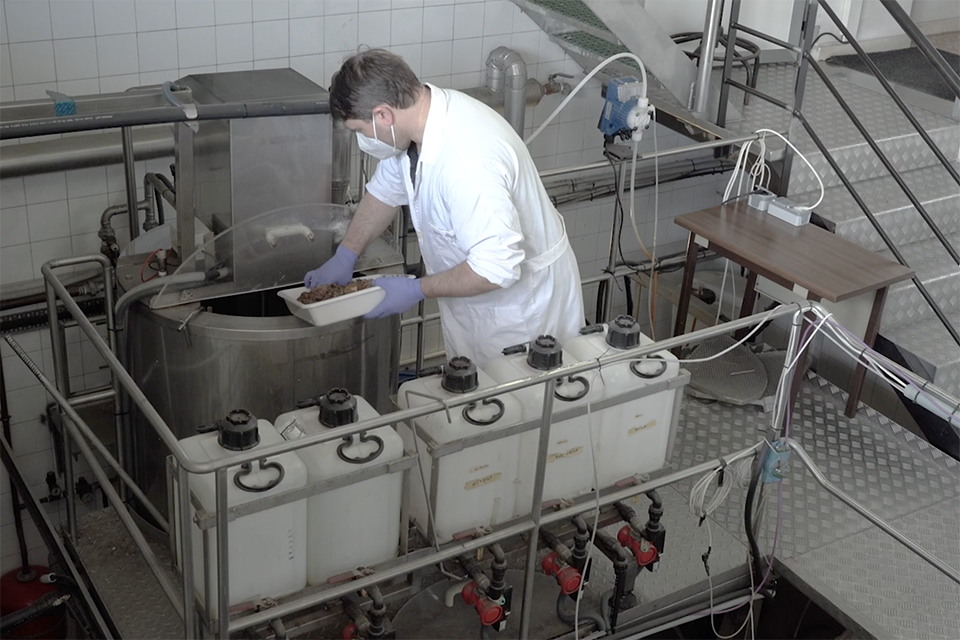
Responsibility
Circular economy: Hydrolysates of aquaculture byproducts as feed
In the latest GAIN article, fish scraps can be transformed into fish protein hydrolysates as a high-nutrient value addition to aquafeeds.
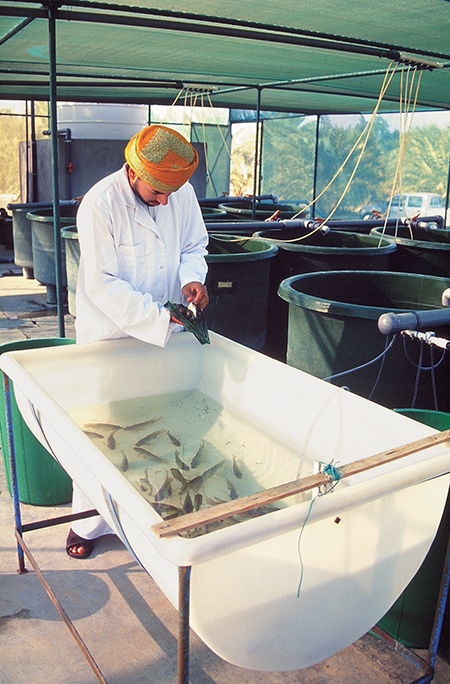
Health & Welfare
Feed ingredient digestibility
Determining the digestibility of protein and other nutrients in feed ingredients is an important step in the formulation of balanced feed.
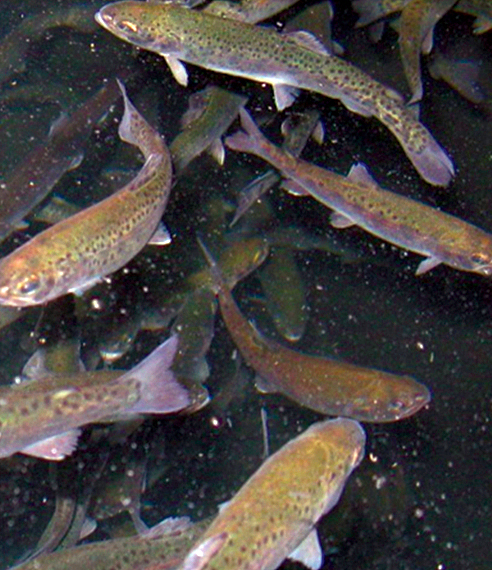
Aquafeeds
Alternative lipids spare fish oil in rainbow trout feeds
Alternative lipids have achieved varied success in ensuring adequate growth and fatty acid composition in fillets. The authors evaluated rainbow trout raised on diets containing fish oil or a blend of fish and standard or modified lipids varying in fatty acid composition.



